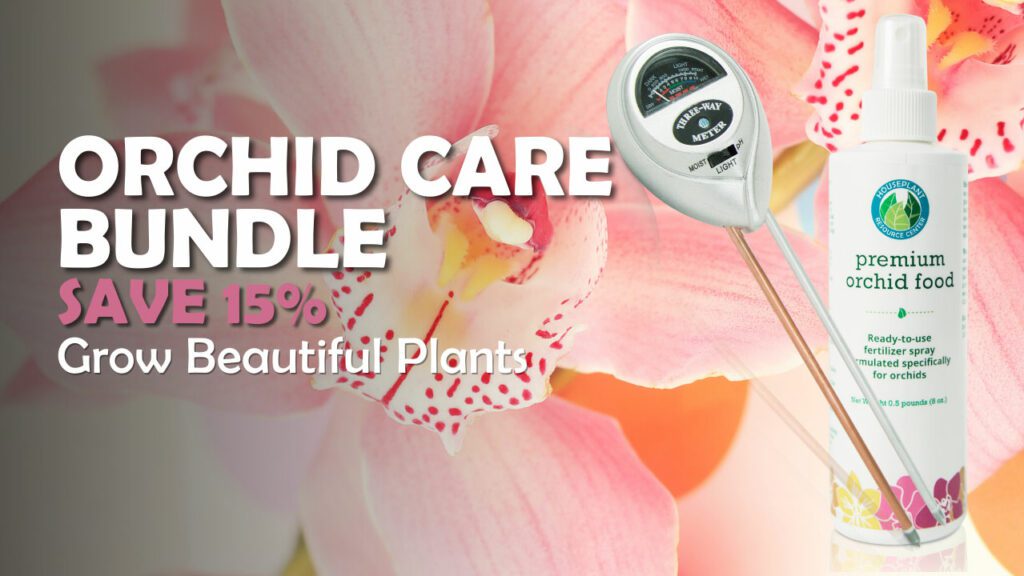Learn what makes orchids so unique, how to identify which orchid species you have, and how to master orchid care in our ultimate guide to orchids.
Orchids are an incredibly diverse plant family that boasts some of the most exotic and beautiful blooms in the world.
It’s not surprising, then, that orchids make wonderful house plants since they add a special touch to any room with their dazzling colors, intricate flower shapes, lush green leaves, and—depending on the variety—unique fragrances.
The key to growing a thriving and diverse orchid collection of your own is to master a few important orchid-care basics. Once you have the basics covered, you can build on your orchid knowledge, troubleshoot when your plants look distressed and grow an impressive collection of exotic plants that burst into bloom every year.
Let’s dive into what makes orchids unique, how you can identify your orchid species, and which plant- care basics are essential in our ultimate guide to orchids.
What Makes Orchids Unique?
Orchids are unique plants not only for their intricate blooms, arc-like stems, and bold foliage, but also because they come in over 25,000 species (with more than 100,000 varieties available).
Each orchid species grows in a different natural habitat and requires different care, attention, and environmental conditions to thrive. Once you know which orchid species you have, caring for it becomes infinitely more simple.
For a collection of interesting facts about different orchid species, visit our article “Orchids in the Wild: 6 Little-Known Facts About Your Favorite Wildflowers.”
Let’s take a deeper look at some of the most common orchid species so you can identify which type you have at home.
What Type of Orchid Do I Have?
Since the orchid family is the largest family of flowering plants in the world, it’s virtually impossible to cover all traits of all orchid types here. But we are excited to share with you some telltale traits of the most common orchid types available on the market—and the ones most likely to be in your indoor garden.
Phalaenopsis Orchids (Moth Orchids)
The moth orchid is native to Southeast Asia, the Philippines, and northern Australia, but you’ve probably seen these orchids at your local nursery or in your local grocery store. They’re by far the most popular type of orchid available at retailers and big-box stores.
Moth orchids have lush, showy blooms that can last between two and six months. They also boast the classic orchid arc since their primary stem often bends under the weight of its blooms. Moth orchids come in a wide variety of colors, including white, yellow, pink, and purple.
Cymbidium Orchids
Cymbidium orchids flower abundantly from late winter until early spring. Typically, blooms last between six and eight weeks. They are large plants with strap-like leaves and long sprays of showy flowers. They also have pseudobulbs and thick, fleshy roots.
Dendrobium Orchids
Dendrobium orchids are native to Asia and are found abundantly in regions of China, Tibet, India, Vietnam, Thailand, and Laos. They’re easily identified by their delicate flowers that occur along a long stem, often bending it so the plant appears top-heavy. Blooms come in an array of pastel colors.
Cattleya Orchids
Cattleya orchids are commonly considered corsage orchids. They have bright, showy blooms that have three sepals, each accompanied by three petals. One petal is typically modified to form a prominent lip that often boasts eye-catching patterns. Unlike most orchids, Cattleya orchids can bloom twice a year.
Cattleyas are native to tropical regions in the Americas, such as Costa Rica and Argentina. They’re popularly grown in greenhouses and other bright and humid indoor environments.
Professional Tip: If you don’t have one of the common orchid varieties listed above, head over to our article “10 Easy-to-Grow Orchid Types for Your Indoor Garden” for additional information on common orchid types.
The Ultimate Guide to Orchids Care Routine: Master the Basics
Once you’ve identified which type of orchid you have (or want to buy), you’ll want to master three key elements in plant care: sunlight, water, and potting mix.
Orchid Potting Mix
Typically, tropical orchids are epiphytes, meaning they don’t grow in regular soil. In the wild, many tropical and subtropical orchids grow clinging to the branches of trees. If you use regular soil or a traditional potting mix for epiphytes, you’ll suffocate their roots and accidentally kill your orchid. For best results, buy an orchid potting mix that is well-draining so as to provide your orchid’s roots with plenty of air.
Professional Tip: A great compliment to well-draining soil is a humidity tray. You can buy a commercial humidity tray for your orchid, or you can make your own by placing your orchid on a saucer filled with pebbles or small stones.
Watering
Watering your orchid doesn’t have to be complex. In fact, it can be remarkably simple if you stick to this golden rule of thumb: less is more.
An easy way to know if your orchid needs water is to insert the tip of your finger into the growing mix to check if the mix is dry. If the mix feels damp (or if you’re not sure), then don’t water your orchid. For most orchid types, you should reduce watering during the winter months when your plant goes dormant to prepare to bloom in the spring.
Professional Tip: One of the best ways to ensure you’re not overdoing it is to water your orchid by leaving a few ice cubes in the pot. This slow release of water will prevent root rot and keep your orchid from sitting in water.
Sunlight
Though preferred light levels depend on your orchid type, most epiphytic orchids enjoy bright indirect sunlight.
Place orchids that enjoy bright light in a south- or west-facing window. Place orchids that enjoy low light conditions in an east- or north-facing window. Low-light orchids can also be positioned a few feet from the window so direct sunlight won’t reach the plant.
Professional Tip: Keep in mind that direct sunlight can easily burn your orchid. Some growers choose to put a sheer curtain between the orchid and its light source to diffuse direct sun rays.
Fertilizer
It wouldn’t be the ultimate guide to orchids if we didn’t talk about fertilizer!
Once you’ve identified your orchid species and mastered the basics of orchid care, there’s one more thing you’ll want to do to really lock in your orchid-growing success: use a gentle fertilizer to ensure your plant is well nourished.
Specialized orchid fertilizers are different from traditional plant fertilizers. Their formulas are designed specifically for the unique needs of your orchid plant. The right orchid food will encourage healthy root growth, lush foliage, and reliable blooms.
For best results, keep it simple. And use an orchid fertilizer that isn’t too acidic, and choose one that doesn’t have complicated feeding instructions.
Professional Tip: Use our Premium Orchid Food to nourish your orchid with an easy-to-use spray formula. Simply spray the Orchid Food on your orchid’s leaves, roots, and potting mix every time you water. Then sit back and watch your plant bloom.
Orchid Life Cycles
It’s no secret that orchid owners (im)patiently await the blooming of their orchids, sometimes for a year or more! Orchids have a series of cycles they go through that allow them to produce their beautiful blooms, and the cycle starts with root growth. From there, they go through a leaf growth cycle, then they flower, and then fall into dormancy before starting the whole cycle over again. Understanding the life cycle of an Orchid will help when deciding whether to prune or repot your plant, and can help you understand that your plant doesn’t just die after the blooms fall off.
Root Growth
In this stage, the plant is focused on growing more roots to support the upcoming leaf growth and flowering. During this stage of growth, you’ll want to supplement your normal plant food regimen with more phosphorus and potassium, which are the essential nutrients for strong roots.
Leaf Growth
The leaf growth stage of the life cycle allows the orchid plant to focus its energy on growing more foliage. This helps the plant receive more energy from the indirect light it gets, and is one of the first outwardly visible signs that your orchid will be blooming soon.
Flowering
After the plant has grown enough new foliage, it begins to produce flower spikes. This flower spike will continue to grow until it reaches maturity and blooms. The beautiful flowers on the end of these spikes can last anywhere from a few weeks to several months, depending on the variety and how healthy your plant is.
Dormancy
After blooming , the plant enters a period of rest. It’s normal to see the foliage start to lose some of its vibrancy, and they may even drop off, but this time is important for your orchid to rest. It’s a good idea to find a cooler spot in your home for the orchid during the dormancy phase, just don’t forget to check the moisture level in the soil, and water when necessary. It will be less frequent than when the plant is in any of the other active phases of its life cycle.
How to Encourage New Blooms
Here are some helpful tips on how to encourage new blooms:
- Provide Adequate Lighting
- Regulate Temperature and Humidity
- Proper Watering Technique
- Fertilize Regularly
- Give your Orchid Rest
Allowing your orchid to rest will signal to the plant that it’s time to store some energy in order to bloom again as it goes back through the life cycle. To give your orchid rest during the dormant cycle, move it to a slightly colder room, and give it just a little less light. It still needs some light, so don’t take it away from the light completely. During this rest phase, keep up on watering it-it may be less frequent, but the plant will still need a fairly regular watering schedule.
For more guidance on how to get your orchid to rebloom, visit our guide on How to Get Orchids to Rebloom.
How to Propagate Orchids
Orchids are an incredibly interesting plant, as they reproduce differently than many other plants when they live in their natural habitat. You can use their method of reproduction to propagate many new orchids to fill your home with, or to give to other plant lovers! Our guide, How Orchids Reproduce: A Guide to Propagating Your Orchid Plant has a ton of information on how this happens, and how you can have basically an endless supply of brand new baby orchid plants!
Common Orchid Problems
Unfortunately, sometimes our beautiful Orchids don’t look their best, and you can tell that something just isn’t right with them. Here are a few of the most common orchid problems to look out for. For more information on these problems and how to fix them, visit our guide on these 5 Common Orchid Problems.
Common problem number one is shriveling buds. This can happen for a few reasons, but the most common is a sudden change in their environment. Another common problem is spotted blooms. This is another pretty disappointing problem to face, mostly because of how long orchid owners have to wait to enjoy those gorgeous blooms. The other common problems covered in our guide linked above are pleated foliage, brown leaf tips, and dropping leaves.
Join Our Orchid Care Facebook Community
In our Facebook group of orchid lovers, we’re dedicated to creating a rich and engaging environment where plant lovers can come together and share tips, tricks, and experiences.
If you’re an orchid lover, come join our Facebook community! We can’t wait to celebrate your successes and help you troubleshoot your care routine.
For continued success, you can explore our other articles or visit our online shop for plant care products that are sure to keep your plants boasting rich green leaves and big, bountiful blooms year-round.



